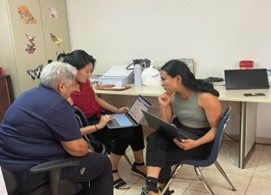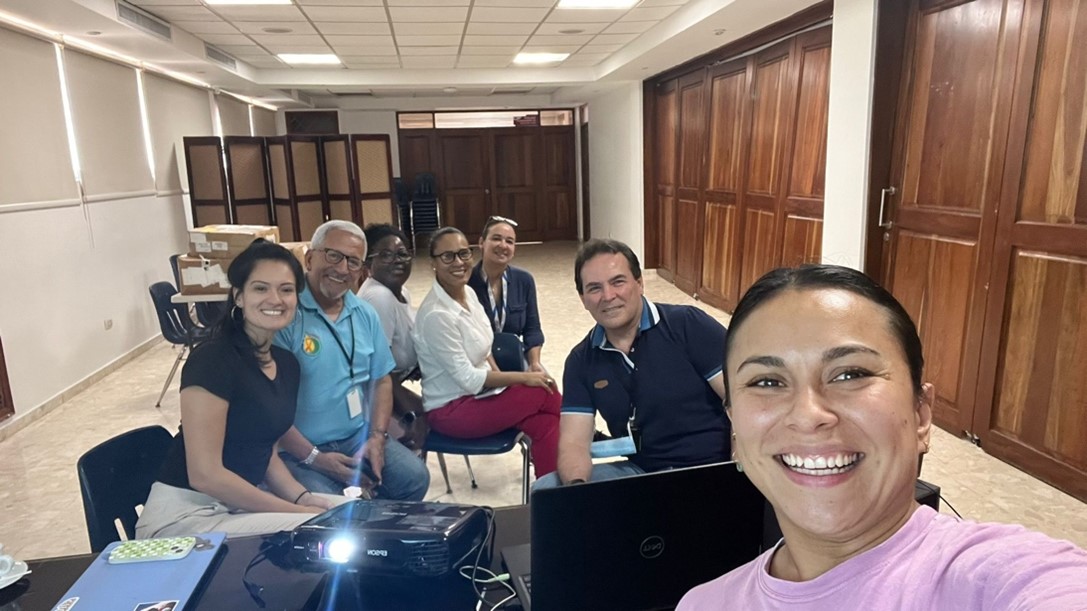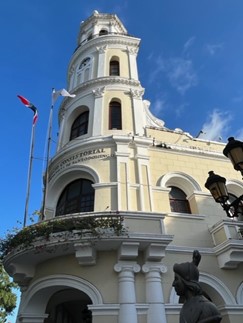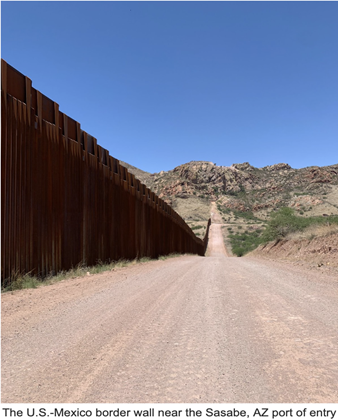¡Hola! My name is Tiffiany Portacio and I am an incoming second-year MPH student at UNC Gilling’s School of Global Public Health in the Health Behavior concentration. This summer I have the privilege of completing my summer practicum in Santo Domingo, Dominican Republic (DR) along with HB classmate, Sophia Mus.

Dr. Yeycy Donastorg at IDCP.
I am currently working with the Instituto Dermatologico y Cirugia de Piel (IDCP), which is a private non-profit institution, located in the capital city of the DR, Santo Domingo. Their mission is to provide specialized integrated services in dermatology, mycology, leprosy, sexually transmitted infections, among other conditions. IDCP also offers accessible health services and education for the local community. Dr. Clare Barrington, professor and director of doctoral program in the Department of Health Behavior, had established a collaboration with the HIV Vaccine and Research Unit at IDCP, led by Dr. Yeycy Donastorg, nearly twenty years ago. This partnership has served as a pathway for several Gillings students to have completed practica and other research collaborations with IDCP.

For general public health context, the DR has experienced an epidemiological transition, where the burden of non-communicable disease is increasing, while the country continues to struggle with ongoing burden of infectious disease, including HIV. Populations who disproportionately experience worse health outcomes are transgender women and cisgender female sex workers living with HIV and type 2 diabetes. My practicum experience will support two ongoing applied research studies led by Drs. Barrington and Donastorg focused on HIV and other chronic conditions, including type 2 diabetes and hypertension.

The first study is to develop a model of integrated care for HIV and noncommunicable diseases, specifically Type 2 diabetes and hypertension, tailored for cisgendered female sex workers. The other study will determine preliminary efficacy of a multilevel intervention (called GAP – Gender Affirming Abriendo Puertas) to improve HIV outcomes among transgender women by reducing stigma and increasing social cohesion as well as provide insight into the use of sequential implementation at the individual and community levels. My two practicum deliverables, which will support each study respectively, will be to conduct qualitative interviews with healthcare providers who work on HIV and/or noncommunicable diseases and to develop a detailed plan for monthly community support sessions to guide implementation of the community engagement component of the intervention.
It has been about a week since Sophia and I have arrived to Santo Domingo, and I believe we have acclimated quite quickly. We both are fluent in Spanish and have traveled extensively throughout Latin America. Nonetheless, novelty fills our day – from getting familiarized with new vocabulary and the neighborhood, to taking public transportation and the general pace of life. The team at IDCP have been incredibly sweet and accommodating both in and out of work. In just a matter of a couple of days, they have dedicated many hours to proofreading and providing feedback for an important survey we have been working on in RedCap, which will allow us to jumpstart on our practicum deliverables. I have done data entry work on RedCap before, yet this is the first time I have dived into the deep end on this software and it has been quite exciting to be able to dissect questions and think of more efficient ways to gather data while still capturing key measures. It has also been especially rewarding to be able to implement survey method skills, with my favorite so far being thinking through and executing code for branching logic. Outside of nerding out to study intervention logistics, many of our colleagues have also made themselves available to give us a tour around the city and even take us out to do a beach-front Zumba class!
We are lucky to live right in the middle of the colonial city in Santo Domingo. Sometimes I find it hard to wrap my head around the history that is dripping from every corner of the city – from the first church and hospital built in the new world to Christopher Columbus’ son’s living quarters just around the corner from our apartment. It is wild to know that in the shores of this island is where the cancer of colonization in the new world would set its foundation to then metastasize its turbulent and bittersweet fate onto the rest of Latin America. The effects of this on the health of populations across the region are seen to this day. However, that is an idea I hope to explore on my next blog entry.
As a pastime and coping mechanism against the infernal summer heat, I have taken it upon myself to jot down intriguing typical sayings colleagues and neighbors have shared with me. The Dominican culture is rich in expressions and idioms that reflect the culture and people’s values, humor, and outlook on life. One that I will leave you all with, which has been sitting on my mind lately as I have commenced my practicum experience, is “El que busca, encuentra”. This saying translates to “She/He who seeks, finds.” It highlights the idea that effort and persistence can lead to successful outcomes and, to me, symbolic of my time here. Although I am working in a new country and with a population I have not worked with before – I seek to learn and, collectively, define and reach success for all parties involved.
¡Hasta pronto!
– Tiffiany


 Medicine physician. Together, we volunteered at Casa Alitas on projects including creating art and decorations for the newest shelter, hanging clotheslines for the guests to dry their clothes, and creating a medication catalog for the medical staff. We also volunteered with other local humanitarian aid organizations including
Medicine physician. Together, we volunteered at Casa Alitas on projects including creating art and decorations for the newest shelter, hanging clotheslines for the guests to dry their clothes, and creating a medication catalog for the medical staff. We also volunteered with other local humanitarian aid organizations including 